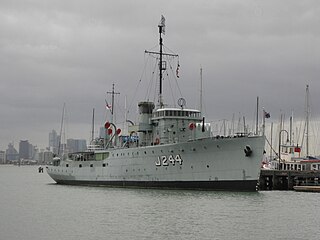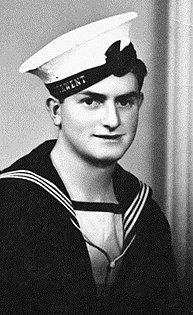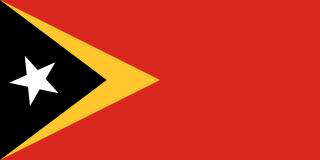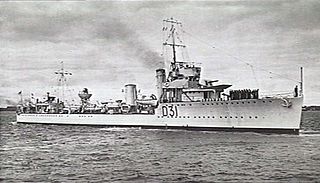
HMAS Quiberon (G81/D20/D281/F03) was a Q-class destroyer of the Royal Australian Navy (RAN). Although built for the Royal Navy and remaining British property until 1950, Quiberon was one of two Q-class destroyers commissioned into the RAN during World War II. She was passed into full RAN ownership in 1950, and converted into an anti-submarine frigate.

HMAS Betano was a Balikpapan-class heavy landing craft operated by the Royal Australian Navy (RAN).

HMAS Castlemaine (J244/M244/A248), named for the city of Castlemaine, Victoria, was one of 60 Bathurst-class corvettes constructed during World War II, and one of 36 initially manned and commissioned solely by the Royal Australian Navy (RAN).

HMAS Colac (J242/M05), named for the town of Colac, Victoria, was one of 60 Bathurst-class corvettes constructed during World War II, and one of 36 initially manned and commissioned solely by the Royal Australian Navy (RAN).

HMAS Cootamundra (J316/M186), named for the town of Cootamundra, New South Wales, was one of 60 Bathurst-class corvettes constructed during World War II, and one of 36 initially manned and commissioned solely by the Royal Australian Navy (RAN).

HMAS Gympie (J238/M238), named for the city of Gympie, Queensland, was one of 60 Bathurst-class corvettes constructed during World War II, and one of 36 initially manned and commissioned solely by the Royal Australian Navy (RAN).

HMAS Inverell, named for the town of Inverell, New South Wales, was one of 60 Bathurst-class corvettes constructed during World War II, and one of 36 initially manned and commissioned solely by the Royal Australian Navy (RAN).

HMAS Kalgoorlie (J192/B245/A119), named for the city of Kalgoorlie, Western Australia, was one of 60 Bathurst-class corvettes constructed during World War II and one of 20 built for the Admiralty but manned by personnel of and commissioned into the Royal Australian Navy (RAN).

The Bathurst-class corvettes were a class of general purpose vessels produced in Australia during World War II. Originally classified as minesweepers, but widely referred to as corvettes, the Bathurst-class vessels fulfilled a broad anti-submarine, anti-mine, and convoy escort role.

HMAS Lithgow (J206/M206), named for the city of Lithgow, New South Wales, Australia was one of 60 Bathurst-class corvettes constructed during World War II, and one of 36 initially manned and commissioned solely by the Royal Australian Navy (RAN).

HMAS Maryborough (J195/B248/A122), named for the city of Maryborough, Queensland, was one of 60 Bathurst-class corvettes constructed during World War II, and one of 20 built on Admiralty order but manned by personnel of and commissioned into the Royal Australian Navy (RAN). She was the first naval vessel built in Queensland for the Royal Australian Navy during World War II.

Edward "Teddy" Sheean was a sailor in the Royal Australian Navy during the Second World War. Born in Tasmania, Sheean was employed as a farm labourer when he enlisted in the Royal Australian Naval Reserve in April 1941. Following training at HMAS Derwent and the Flinders Naval Depot, he was posted to Sydney, where he joined the newly commissioned corvette HMAS Armidale in June 1942. Sheean served aboard Armidale as she initially took part in escort duties along the eastern Australian coast and in New Guinea waters, before he transferred with the ship to Darwin in October, where Armidale was given the task of assisting Australian operations in Timor.

HMAS Wallaroo (J222), named after the town of Wallaroo, South Australia, was one of 60 Bathurst-class corvettes constructed during World War II, and one of 36 initially manned and commissioned solely by the Royal Australian Navy (RAN). Wallaroo was one of only three Bathursts lost during World War II; following a collision with US Liberty ship Henry Gilbert Costin on the night of 11 June 1943.

Same is a city in the Same Subdistrict in the interior of East Timor, 81 kilometres (50 mi) south of Dili, the national capital. Same has a population of 7,413 and is the capital of Manufahi District, which was known as Same District in Portuguese Timor.

HMAS Warrnambool (J202), named for the city of Warrnambool, Victoria was one of 60 Bathurst-class corvettes constructed during World War II, and one of 36 initially manned and commissioned solely by the Royal Australian Navy (RAN). Warrnambool sank after she hit a mine in the Great Barrier Reef on 13 September 1947. She was one of only four Bathurst class corvettes lost while in Australian service, and the only one lost after World War II.

HMAS Dubbo (J251/M251), named for the city of Dubbo, New South Wales, was one of 60 Bathurst-class corvettes constructed during World War II, and one of 36 initially manned and commissioned solely by the Royal Australian Navy (RAN).

HMAS Geraldton (J178/B242/A116), named for the city of Geraldton, Western Australia, was one of 60 Bathurst-class corvettes constructed during World War II and one of 20 built for the Admiralty but manned by personnel of and commissioned into the Royal Australian Navy (RAN).























